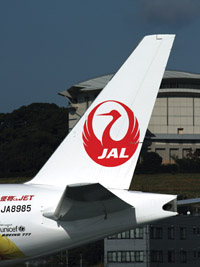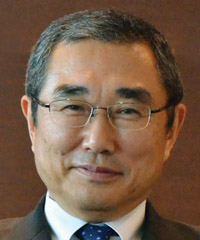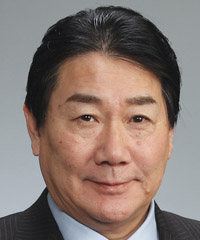News Backgrounder
JAL relists, but questions remain
October 1st 2012
Last month, to the delight of investors, alliance partners, customers, employees, the Enterprise Turnaround Initiative Corporation (ETIC) and the governing Democratic Party of Japan (DPJ), Japan Airlines (JAL) relisted on the Tokyo Stock Exchange (TSE) as the world’s most profitable airline. Read More »
 |
| Japan Airlines: leaner and meaner than ever, but its opponents claim it has had favourable treatment |
The transformation came 973 days after JAL had entered humiliating bankruptcy protection in January 2010 and was struck off the rolls of the TSE.
But before the ringing of the traditional bell signalling the resumption of trading faded away and celebrations came to an end, there was a warning for the JAL management not to let success go to their heads. Renewed accusations surfaced from opposition politicians and major rival, All Nippon Airways (ANA), that JAL’s rehabilitation was “unfair”.
The stock price was set at 3,790 yen (US$48.5), about five times the carrier’s earnings forecast for 2012. Demand for shares exceeded supply and JAL overtook ANA to become Japan’s largest carrier by market value.
Credit for the turnaround must go to Kazuo Inamori, management guru and founder of high-tech company, Kyocera, appointed by the new DPJ government to sort out the floundering carrier.
Drastic cost-cutting was the key to JAL’s quick recovery. The carrier slashed staff numbers, reduced salaries and pensions, cut routes and grounded gas-guzzling, inefficient aircraft.
Now chairman emeritus, Inamori spoke of the danger of hubris. JAL must avoid becoming “inflated with pride” about its current earnings structure, he warned.
After previous successful restructurings, JAL slipped back into bad habits with excessive aircraft orders and plunging into reckless route expansion.
 |
| 'The rehabilitation process has distorted the competitive environment' |
| Shinichiro Ito President All Nippon Airways |
JAL still thought that it was its duty as national flag carrier to serve as many routes as possible for public good.
Scathingly dismissing the airline’s management as “unfit to run a fruit and vegetable stall” when he took control in early 2010, Inamori subsequently gave JAL employees a strong dose of his profit-focused philosophy, through meetings and lectures. His 125-page white-bound book, JAL Philosophy, is compulsory reading for employees at all levels.
“I desperately wanted to rebuild the airline, but I wasn’t sure we could do it. I feel vindicated now that we’ve done it”, said Inamori.
JAL president, Yoshiharu Ueki, told media at a TSE press conference that the relisting was “part of our bigger goal of steady profitability”.
However, in a media interview, ANA president, Shinichiro Ito, said the rehabilitation of JAL was “not fair” and urged the Japanese government to take measures to ensure JAL does not gain an undue advantage as a result.
“The rehabilitation process has distorted the competitive environment. We are concerned that the rehabilitation of JAL was not quite fair,” he said.
Ito noted that ANA’s new 175 billion yen share issue in July was partly aimed at defending itself against a revitalized rival. “We needed to strengthen our financial base to compete with a stronger JAL,” said the ANA chief.
On September 21, ANA announced an order for 11 more B787s, bringing total orders of the new aircraft to 66, including 13 in service.
ANA and its political supporters have been insisting that JAL’s rehabilitation plans conform to European Union (EU) guidelines on “public support” for airlines undergoing corporate restructuring with state aid.
 |
| '[Relisting] part of our bigger goal of steady profitability' |
| Yoshiharu Ueki President Japan Airlines |
JAL pointed out the guidelines were introduced because there were many different countries in the EU and a consistent framework was necessary for fair play. There were no such guidelines in either the U.S. or Japan.
Examples of EU restrictions included the increase of seat supply must not exceed market level, carriers undergoing rehabilitation could not become “price leaders” and governments must not favour airlines receiving assistance with priority rights and other opportunities.
By the end of the 2012 financial year, JAL will have reduced international seat supply by 40% and the domestic supply by 30% compared with 2008.
JAL estimates the amount of passenger flow to ANA had been worth about 70 billion yen in 2010-2011, which, said the carrier, did not appear to be unfair to ANA.
So far as “price leading” is concerned, the birth of LCCs in Japan has changed the air fare situation radically.
JAL’s opponents claim the new Narita-Boston route, opened in April, and the carrier’s investment in LCC Jetstar Japan were “serious problems”, which have a direct effect on the internal market.
ANA and opposition party politicians are calling on the government to deny JAL new domestic slots at Haneda in 2013 when another 25 slots become available. JAL’s response is that its allocation should match ANA and other carriers.
Another argument put forward by JAL’s critics was that as JAL obtained a publicly supported loan, the introduction of new aircraft, which could improve competitiveness, should not be allowed.
JAL’s response was that making it use old, inefficient aircraft that were partly responsible for its need to rehabilitate, did not make sense.
JAL benefitted from a tweaking of the Japanese tax code in 2011. Japanese companies already in bankruptcy protection or making losses can continue to use 100% of their cumulative losses to offset tax for seven years. This, said ANA, gave JAL an advantage.
After the trauma of bankruptcy, JAL has a clean balance sheet, which means less risk and lower interest payments. Also, it can take advantage of lower depreciation costs tied to the post-bankruptcy write-down of its fleet.
IATA director general and CEO, Tony Tyler, speaking at a press conference in Tokyo coincidentally on the day of JAL’s TSE relisting, said Japan should ensure a fair and transparent policy for all airlines operating in the country.
“No airline should be given special favors, but neither should any airline be penalized,” he said.
Tyler added he did not see any point in penalising Japan Airlines after helping with its rehabilitation.
Japan’s transport minister, Yuichiro Hata, said the ministry would “closely watch JAL’s rehabilitation progress to see whether the public assistance has distorted the circumstances of competition”.
At the TSE press conference, JAL president Ueki said after years of being “unable to make sufficient investments”, the carrier will provide more attractive products and services.
Last month, JAL announced it would have new seats in all four classes of its 777-300ER aircraft on key international routes, plus revamped inflight menus.
Coordinating the turnaround with Inamori was the government-supported ETIC, JAL’s major shareholder since January 2010 when the company filed for court-protected bankruptcy. Since then JAL has received loans totalling 350 billion yen from the corporation.
ETIC extends funds procured through financial markets. There was no direct government funding with JAL, although if the process had failed the government would have covered the losses.
These loans had to be paid back within three years and at the time of their issue it was thought it would be a close run race for JAL to succeed. But succeed it has.
JAL is leaner and meaner than it has ever been. But there is trouble ahead. The price of fuel is bound to rise and the global economy is uncertain. Japan’s territorial dispute with China threatens bilateral trade and lucrative tourism links. At home and abroad the menace of LCCs will become a bigger threat to born-again JAL’s existence.
This was reflected in the first days of trading, described as ‘sluggish ’by analysts.
But the announcement on September 21, the third day of trading, that JAL was cutting frequencies on some Japan-China routes in October following passenger cancellations, sent the new stock below the IPO price for the first time.
Welcome back to the market, JAL.